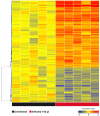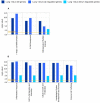Transcriptional profiling of disease-induced host responses in bovine tuberculosis and the identification of potential diagnostic biomarkers
- PMID: 22359547
- PMCID: PMC3281027
- DOI: 10.1371/journal.pone.0030626
Transcriptional profiling of disease-induced host responses in bovine tuberculosis and the identification of potential diagnostic biomarkers
Abstract
Bovine tuberculosis (bTb) remains a major and economically important disease of livestock. Improved ante-mortem diagnostic tools would help to underpin novel control strategies. The definition of biomarkers correlating with disease progression could have impact on the rational design of novel diagnostic approaches for bTb. We have used a murine bTb model to identify promising candidates in the host transcriptome post-infection. RNA from in vitro-stimulated splenocytes and lung cells from BALB/c mice infected aerogenically with Mycobacterium bovis were probed with high-density microarrays to identify possible biomarkers of disease. In antigen-stimulated splenocytes we found statistically significant differential regulation of 1109 genes early (3 days) after infection and 1134 at a later time-point post-infection (14 days). 618 of these genes were modulated at both time points. In lung cells, 282 genes were significantly modulated post-infection. Amongst the most strongly up-regulated genes were: granzyme A, granzyme B, cxcl9, interleukin-22, and ccr6. The expression of 14 out of the most up-regulated genes identified in the murine studies was evaluated using in vitro with antigen-stimulated PBMC from uninfected and naturally infected cattle. We show that the expression of cxcl9, cxcl10, granzyme A and interleukin-22 was significantly increased in PBMC from infected cattle compared to naïve animals following PPD stimulation in vitro. Thus, murine transcriptome analysis can be used to predict immunological responses in cattle allowing the prioritisation of CXCLl9, CXCL10, Granzyme A and IL-22 as potential additional readout systems for the ante-mortem diagnosis of bovine tuberculosis.
Conflict of interest statement
Figures






Similar articles
-
Upregulation of IL-17A, CXCL9 and CXCL10 in early-stage granulomas induced by Mycobacterium bovis in cattle.Transbound Emerg Dis. 2013 Dec;60(6):525-37. doi: 10.1111/j.1865-1682.2012.01370.x. Epub 2012 Aug 22. Transbound Emerg Dis. 2013. PMID: 22909117
-
Differential gene expression in Mycobacterium bovis challenged monocyte-derived macrophages of cattle.Microb Pathog. 2017 Dec;113:480-489. doi: 10.1016/j.micpath.2017.11.030. Epub 2017 Nov 21. Microb Pathog. 2017. PMID: 29170044
-
Antigen stimulation of peripheral blood mononuclear cells from Mycobacterium bovis infected cattle yields evidence for a novel gene expression program.BMC Genomics. 2008 Sep 29;9:447. doi: 10.1186/1471-2164-9-447. BMC Genomics. 2008. PMID: 18823559 Free PMC article.
-
Gene expression profiling of the host response to Mycobacterium bovis infection in cattle.Transbound Emerg Dis. 2009 Aug;56(6-7):204-14. doi: 10.1111/j.1865-1682.2009.01082.x. Epub 2009 May 26. Transbound Emerg Dis. 2009. PMID: 19486308 Review.
-
Cell-Mediated Immunological Biomarkers and Their Diagnostic Application in Livestock and Wildlife Infected With Mycobacterium bovis.Front Immunol. 2021 Mar 4;12:639605. doi: 10.3389/fimmu.2021.639605. eCollection 2021. Front Immunol. 2021. PMID: 33746980 Free PMC article. Review.
Cited by
-
RNA-seq Transcriptional Profiling of Peripheral Blood Leukocytes from Cattle Infected with Mycobacterium bovis.Front Immunol. 2014 Aug 26;5:396. doi: 10.3389/fimmu.2014.00396. eCollection 2014. Front Immunol. 2014. PMID: 25206354 Free PMC article.
-
Biomarkers for Early Stages of Johne's Disease Infection and Immunization in Goats.Front Microbiol. 2018 Sep 28;9:2284. doi: 10.3389/fmicb.2018.02284. eCollection 2018. Front Microbiol. 2018. PMID: 30323794 Free PMC article.
-
The genetic architecture of complete blood counts in lactating Holstein dairy cows.Front Genet. 2024 Mar 27;15:1360295. doi: 10.3389/fgene.2024.1360295. eCollection 2024. Front Genet. 2024. PMID: 38601075 Free PMC article.
-
Integrative Network Analysis of Predicted miRNA-Targets Regulating Expression of Immune Response Genes in Bovine Coronavirus Infection.Front Genet. 2020 Sep 30;11:584392. doi: 10.3389/fgene.2020.584392. eCollection 2020. Front Genet. 2020. PMID: 33193717 Free PMC article.
-
In-depth systems biological evaluation of bovine alveolar macrophages suggests novel insights into molecular mechanisms underlying Mycobacterium bovis infection.Front Microbiol. 2022 Nov 30;13:1041314. doi: 10.3389/fmicb.2022.1041314. eCollection 2022. Front Microbiol. 2022. Retraction in: Front Microbiol. 2025 Apr 10;16:1605607. doi: 10.3389/fmicb.2025.1605607. PMID: 36532492 Free PMC article. Retracted.
References
-
- Thoen C, Lobue P, de Kantor I. The importance of Mycobacterium bovis as a zoonosis. Vet Microbiol. 2006;112:339–345. - PubMed
-
- Schiller I, Oesch B, Vordermeier HM, Palmer MV, Harris BN, et al. Bovine tuberculosis: a review of current and emerging diagnostic techniques in view of their relevance for disease control and eradication. Transbound Emerg Dis. 2010;57:205–220. - PubMed
-
- Gormley E, Doyle MB, Fitzsimons T, McGill K, Collins JD. Diagnosis of Mycobacterium bovis infection in cattle by use of the gamma-interferon (Bovigam) assay. Vet Microbiol. 2006;112:171–179. - PubMed
-
- Wood PR, Jones SL. BOVIGAM: an in vitro cellular diagnostic test for bovine tuberculosis. Tuberculosis (Edinb) 2001;81:147–155. - PubMed
-
- Lalvani A, Millington KA. T Cells and Tuberculosis: Beyond Interferon-gamma. J Infect Dis. 2008;197:941–943. - PubMed
Publication types
MeSH terms
Substances
LinkOut - more resources
Full Text Sources
Other Literature Sources
Molecular Biology Databases
Research Materials

